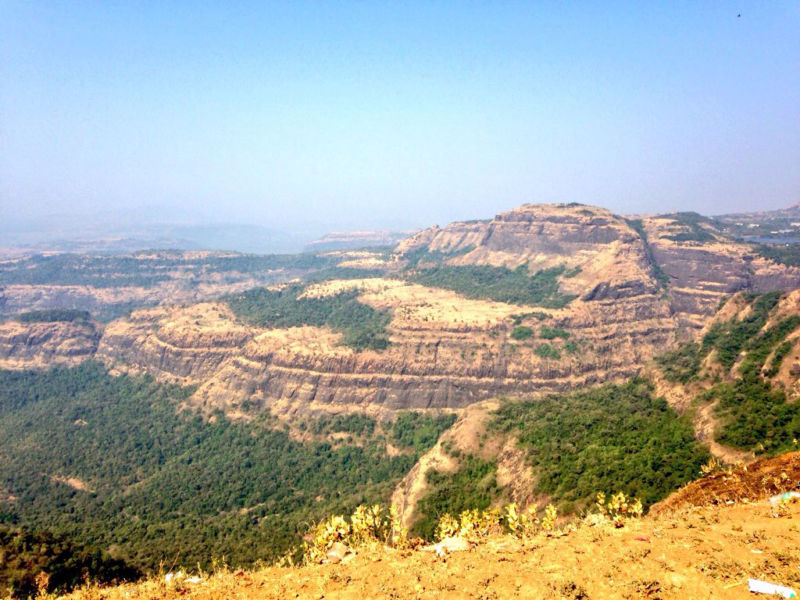
Modeling what happened after a massive asteroid struck the Yucatan has painted a hellscape capable of causing a mass extinction: choking dust, immense tsunamis, and enough debris leaving and reentering the atmosphere to set off global fires. But questions remain whether the impact alone drove the dinosaurs to extinction or if it merely finished the job started by a massive volcanic outburst happening in India.
The Deccan Traps cover an area of roughly a half-million square kilometers, and the eruptions that created them involved over a million cubic kilometers of rock. Immense eruptions like this have been blamed for mass extinctions in the past, as they pump lots of toxic chemicals into the atmosphere and cause a rapid seesaw of cooling and warming. And the Deccan Traps are no exception: people have argued that they were already killing the dinosaurs or had stressed ecosystems in a way that set the stage for a mass extinction. But not everyone has bought in to this idea, and some have suggested that the asteroid collision actually drove changes in the Deccan Traps eruptions.
Sorting all this out requires a better sense of the timing of the eruptions vs. when the impact and extinctions occurred. In today's issue of Science, two papers attempt to narrow down the timing. Unfortunately, their results don't entirely agree.
What and when?
Both papers rely on radiometric dating, but the papers use different types, each with their own limitations. One of them looks at the decay of uranium that's trapped in zircons that form during volcanic activity. The strength of this method is that it's very precise. Its downside is that zircons form at high temperatures, which means the zircons are underground prior to eruptions rather than during the eruption itself. So they don't provide a precise date of the eruption.
To get around this issue, an Indian-Swiss-US team looked at huge amounts of zircons and linked their dates to their specific location in the series of eruptions that built the Deccan Traps. A statistical analysis then identified any outliers—a younger zircon beneath an older layer, for example—and took them into account to build a model of the most probable ages of different eruptions.
This suggested that the Deccan traps were built in pulses, with a large eruption occurring about 100,000 years before the asteroid impact. An even larger one took place almost immediately after.
A second team, this one from India-UK-US, did argon dating. The gas only starts being trapped once a rock solidifies, so it essentially starts the timer during the eruption itself. The hassle is that the gas can sometimes escape from the rock slowly over time, which is less of a problem with zircons.
Overall, this group finds a big picture that overlaps with that of the group that did zircon dating. But there are differences in the details, and some of them are significant. For example, the researchers also find that the Deccan Trap eruptions overlapped with the mass extinction, occurring both before and after the event. But they see no evidence of pulses; instead, they see nearly continuous eruptions. Most of the material (~75 percent), they argue, was put in place after the mass extinction, though.
The researchers' dates are also consistent with a major shift in the properties of the erupted rock occurring at the same time as the impact. This supports the idea that the impact's seismic effects reached across the entire planet.
Eruptions like this release massive quantities of sulfur and carbon dioxide. These have opposing effects. The sulfur forms aerosols that reflect a huge amount of sunlight, causing a cooling. That cooling, however, is short term, as the aerosols don't have a long lifetime in the atmosphere. Carbon dioxide does, and it produces a follow-on warming through the greenhouse effect. This climate seesaw is thought to have contributed to some mass extinctions.
The second paper includes an analysis that correlates the eruptions with signs of the climate change, but it finds they don't line up well. The authors conclude that either something else was going on with the climate, or the release of gasses doesn't always line up with the volume of lava erupted. So that result raises questions about how much the Deccan eruptions would have contributed to ecological disruptions.
Overall, it seems that we have a lot more information, but it isn't necessarily leading to a clearer picture. The results do confirm that significant eruptions were happening before the mass extinction, but the biggest of them seemed to be happening after, and the eruptions' effect on distant ecosystems is unclear. And we don't know whether the eruptions were a small series of enormous outbursts or a relatively steady drumbeat of smaller events.
The good news is that if you're a fan of dinosaurs and want to know how they met their end, there's still science to be done.
Science, 2019. DOI: 10.1126/science.aau2422, 10.1126/science.aav1446 (About DOIs).
https://arstechnica.com/science/2019/02/new-dates-show-massive-volcanic-eruptions-overlapped-with-dinosaurs-death/Bagikan Berita Ini















0 Response to "New dates show massive volcanic eruptions overlapped with dinosaurs’ death - Ars Technica"
Post a Comment